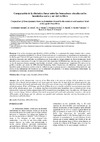Please use this identifier to cite or link to this item:
https://accedacris.ulpgc.es/jspui/handle/10553/57378
| Title: | Comparación de la dinámica dunar entre las formaciones situadas en los hemideltas norte y sur del río Ebro | Other Titles: | Comparison of dune dynamics between formations located in the northern and southern hemideltas of the Ebro River | Authors: | Rodríguez Santalla, Inmaculada Sánchez, María José Montoya Montes, Isabel Gómez, D. Martín, T. Martín Velázquez, Silvia Barrio, F. Serra, Jordi Gracia Prieto, Francisco Javier |
UNESCO Clasification: | 250607 Geomorfología | Keywords: | Field dune GPR Ebro Delta |
Issue Date: | 2017 | Journal: | Geotemas (Madrid) | Abstract: | Uno de los elementos que identifica al delta del Ebro es la presencia de campos dunares más o menos
extendidos en la práctica totalidad de su litoral. Si bien su desarrollo y conservación se encuentran muy amenazados, en
las flechas que limitan al delta por el norte y por el sur, su presencia es característica. Desde el punto de vista ambiental,
una de las cuestiones más relevantes es la diferencia que existe entre los campos dunares de ambas formaciones. En el
hemidelta norte encontramos el campo de dunas activo más importante del Mediterráneo, mientras que en el hemidelta
sur las formaciones dunares muestran una limitada actividad, y están colonizadas por vegetación. El análisis de los
perfiles obtenidos por medio de GPR (Ground Penetrating Radar) demuestran esta diferencia: mientras que en el
hemidelta norte se observan cambios entre los reflectores que se pueden asociar a estructuras sedimentarias de baja
escala, en los radargramas del hemidelta sur los reflectores son paralelos y continuos lateralmente, demostrando un
crecimiento en horizontal, propio de las foredunes. One of the characteristic elements of the Ebro delta is the presence of dune fields in almost its entire coastline. Even though their development and conservation are threatened, the dune fields are widespread in the spits that limit the delta northwards and southwards. One of the most relevant issues is the difference between the dune fields of both formations. While in El Fangar spit (North of Ebro River) it is possible to find the most important active dune field of the Mediterranean area, in la Banya (Southern hemi-delta) dune formations show a limited activity, being colonized by vegetation. Profiles obtained from GPR (Ground Penetrating Radar) show this difference: El Fangar spit dunes present changes between reflectors that can be associated with small scale sedimentary structures, whereas in GPR profiles of La Banya spit the reflectors are parallel and continuous laterally, showing horizontal growth, characteristic of the foredunes. |
URI: | https://accedacris.ulpgc.es/handle/10553/57378 | ISSN: | 1576-5172 | Source: | Geotemas ( Madrid ) [ISSN 1576-5172] (17), p. 287-290 | URL: | http://dialnet.unirioja.es/servlet/articulo?codigo=6398583 |
| Appears in Collections: | Actas de congresos |
Page view(s)
107
checked on Oct 31, 2024
Download(s)
138
checked on Oct 31, 2024
Google ScholarTM
Check
Share
Export metadata
Items in accedaCRIS are protected by copyright, with all rights reserved, unless otherwise indicated.
